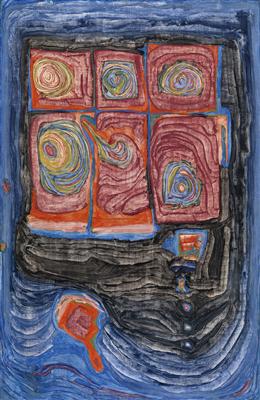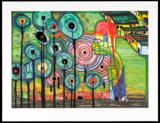Friedensreich Hundertwasser *

(Vienna 1928–2000 Pacific Ocean, on board the Queen Elizabeth II.) “Globulant”, on the reverse signed, dated Hundertwasser 1956 and with the work number 251, and directional arrow and dimensions, oil on canvas (primed with chalk, zinc oxide and isinglass), 117 x 76 cm, framed, (K)
Catalogued and illustrated:
Andrea Christa Fürst, Hundertwasser, catalogue raisonné Vol. II, Taschen, 2002, page 309, catalogue raisonné no. 251 (here with other dimensions).
Exhibited:
Hundertwasser, Galerie H. Kamer, Paris 1957
Welt-Wander-Museumsausstellung- Österreich zeigt den Kontinenten Hundertwasser, The Tel Aviv Museum, Tel Aviv 1976
Published in the exhibition catalogue:
Hundertwasser, Kestner-Gesellschaft, Hannover 1964, page 141 (with ill.)
Welt-Wander-Museumsausstellung- Österreich zeigt den Kontinenten Hundertwasser, National Gallery of Iceland, Reykjavik 1976, page 161 (with ill.), supplement page 34
Provenance:
Galerie Kamer, Paris
Collection Samuel Dubiner, Ramat Gan/Tel Aviv Sotheby’s London, Post War and Contemporary Art, 27 June 1991, lot 29
Private Collection, Toronto
Private Property, France
... In 1955 he published the text “Arte come Transautomatico” in “Arti Visive” magazine, developing for the first time his theory of the “inner film”. In 1956 his manuscript titled La visibilité de la création transautomatique appeared in Cimaise, Paris, and in the same year, in Phases, an example of his Cinéma individuel: Hundertwasser had given one of his paintings 77 titles, their numbered listing intended to indicate the inner film, the “individual film” which observing a painting or watercolour can unleash. In 1957 he summarised his thoughts on the “Grammar of Seeing”.
Although Hundertwasser usually expressed himself poetically, directly and clearly, his theoretical texts are hard to read. He stresses repeatedly that he is moving into virgin territory, that conventional ideas are insufficient, that he uses many expressions only as an aid. It would be worth translating what Hundertwasser wrote about the perception of art during these years into our vernacular and to comment on his system in depth. Here we can only roughly sketch his most important thoughts.
Hundertwasser assumed that what we call “seeing” is very poorly developed, that actually we are visual illiterates, that mankind in general only ever sees and recognises that which he has previously seen, and it is the task of modern art to see the new, indeed to teach new ways of seeing altogether. Thus the more a work of art serves this goal, the more significant it is as a work of art. Like John Ruskin in his Stones of Venice (1853), Hundertwasser believed that the importance of a piece of art lay in its relationship with the multiplicity and quality of the inner ideas which it engenders within us. The status of a painting is determined by the richness of associations it evokes in the widest variety of viewers….
From: “Grammatik des Sehens”, Ed. H. Kamer, Paris, 1957
Specialist: Mag. Elke Königseder
 Mag. Elke Königseder
Mag. Elke Königseder
+43-1-515 60-358
elke.koenigseder@dorotheum.at
29.11.2012 - 18:00
- Realized price: **
-
EUR 268,700.-
- Estimate:
-
EUR 220,000.- to EUR 280,000.-
Friedensreich Hundertwasser *
(Vienna 1928–2000 Pacific Ocean, on board the Queen Elizabeth II.) “Globulant”, on the reverse signed, dated Hundertwasser 1956 and with the work number 251, and directional arrow and dimensions, oil on canvas (primed with chalk, zinc oxide and isinglass), 117 x 76 cm, framed, (K)
Catalogued and illustrated:
Andrea Christa Fürst, Hundertwasser, catalogue raisonné Vol. II, Taschen, 2002, page 309, catalogue raisonné no. 251 (here with other dimensions).
Exhibited:
Hundertwasser, Galerie H. Kamer, Paris 1957
Welt-Wander-Museumsausstellung- Österreich zeigt den Kontinenten Hundertwasser, The Tel Aviv Museum, Tel Aviv 1976
Published in the exhibition catalogue:
Hundertwasser, Kestner-Gesellschaft, Hannover 1964, page 141 (with ill.)
Welt-Wander-Museumsausstellung- Österreich zeigt den Kontinenten Hundertwasser, National Gallery of Iceland, Reykjavik 1976, page 161 (with ill.), supplement page 34
Provenance:
Galerie Kamer, Paris
Collection Samuel Dubiner, Ramat Gan/Tel Aviv Sotheby’s London, Post War and Contemporary Art, 27 June 1991, lot 29
Private Collection, Toronto
Private Property, France
... In 1955 he published the text “Arte come Transautomatico” in “Arti Visive” magazine, developing for the first time his theory of the “inner film”. In 1956 his manuscript titled La visibilité de la création transautomatique appeared in Cimaise, Paris, and in the same year, in Phases, an example of his Cinéma individuel: Hundertwasser had given one of his paintings 77 titles, their numbered listing intended to indicate the inner film, the “individual film” which observing a painting or watercolour can unleash. In 1957 he summarised his thoughts on the “Grammar of Seeing”.
Although Hundertwasser usually expressed himself poetically, directly and clearly, his theoretical texts are hard to read. He stresses repeatedly that he is moving into virgin territory, that conventional ideas are insufficient, that he uses many expressions only as an aid. It would be worth translating what Hundertwasser wrote about the perception of art during these years into our vernacular and to comment on his system in depth. Here we can only roughly sketch his most important thoughts.
Hundertwasser assumed that what we call “seeing” is very poorly developed, that actually we are visual illiterates, that mankind in general only ever sees and recognises that which he has previously seen, and it is the task of modern art to see the new, indeed to teach new ways of seeing altogether. Thus the more a work of art serves this goal, the more significant it is as a work of art. Like John Ruskin in his Stones of Venice (1853), Hundertwasser believed that the importance of a piece of art lay in its relationship with the multiplicity and quality of the inner ideas which it engenders within us. The status of a painting is determined by the richness of associations it evokes in the widest variety of viewers….
From: “Grammatik des Sehens”, Ed. H. Kamer, Paris, 1957
Specialist: Mag. Elke Königseder
 Mag. Elke Königseder
Mag. Elke Königseder
+43-1-515 60-358
elke.koenigseder@dorotheum.at
|
Buyers hotline
Mon.-Fri.: 10.00am - 5.00pm
kundendienst@dorotheum.at +43 1 515 60 200 |
| Auction: | Contemporary Art |
| Auction type: | Saleroom auction |
| Date: | 29.11.2012 - 18:00 |
| Location: | Vienna | Palais Dorotheum |
| Exhibition: | 17.11. - 29.11.2012 |
** Purchase price incl. buyer's premium and VAT
It is not possible to turn in online buying orders anymore. The auction is in preparation or has been executed already.
More objects by this artist
-

Starting bid:
EUR 1,200.- -

Starting bid:
EUR 360.- -

Starting bid:
EUR 220.-
